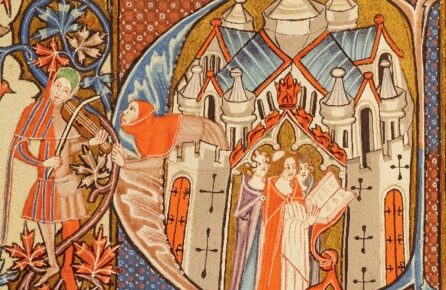
What would an introductory guide to medieval music look like if it were based around the humans involved in music-making? It’s perhaps not surprising that medieval music history has often been written around genres – musical objects – rather than people, because so many of medieval music’s personalities are simply unknown. In writing Medieval Polyphony and Song, less than half the music we wanted to cover could be attributed to a named composer, and the names of its original performers have all but vanished. Nevertheless, the state of knowledge of medieval people and their lives in general has never been better, and we can say a great deal now about the different social groups who cultivated music, created it, performed it, studied it, sponsored it through patronage, listened to it, and passed it on – even if we don’t know their names. We wanted to put people at the heart of the book’s organization so as to be able to share with readers how music formed part of medieval lives. A human-centred approach enabled us to bring in a much wider range of people connected to medieval music-making, rather than just “composers” (which is a problematic concept for quite a lot of medieval music anyway), and also helped us to incorporate a broader range of musical traditions, not all of which were preserved in writing.
To translate this conceptual approach into actual chapters of the book, we used geographical areas, opening each chapter with a description (and a map) of a particular region, and its political, social and linguistic situation. From this broad context, we could then focus in on sites and institutions where musical performance, education, or creation took place, and examine the lives of the people who lived and worked there. Structuring things in this way made it much easier to draw attention to the connections between different kinds of music-making that – in a genre-based history – would have been treated separately.
This brings us to the question of the book’s title and coverage: why medieval polyphony and song? What do these categories signify and why bring them together? Both terms are extremely broad: “song” encompasses music for both religious and secular performance, in a wide variety of ecclesiastical, courtly and urban spaces, and in both Latin and in vernacular languages: the precursors of modern Dutch, English, French, German, Italian, Portuguese and Spanish. “Polyphony” is also a wide category, including any music in more than one part, whether that be singing chant in parallel fourths or fifths, or creating the dense contrapuntal structures of late-medieval motets. A lot of instrumental music is effectively included too, since all polyphony could be played on instruments or using a combination of instruments and singers, and all songs could be accompanied on instruments; song-melodies could be, and were, played instrumentally, and formed the basis for instrumental improvisation. But “polyphony” and “song” are also overlapping terms, since some songs were polyphonic from the outset, and others exist in both monophonic and polyphonic versions. And those are just the ones we know about from notated traces: iconographic and literary evidence suggests that songs whose notated form is a single melodic line were often accompanied on instruments, becoming polyphonic in performance, even if the precise nature of those accompaniments is not easy for us to recover. More often than not, the categories of “polyphony” and “song” are intertwined in the music of the Middle Ages, either musically or contextually, since polyphony and song were frequently cultivated by the same musicians in the same places.
And those musicians were a diverse set of people. We include music created and sung by women as well as men, by Jewish and Muslim musicians as well as Christians, and by laypeople as well as the highly-educated clergy. We travel around the continent of Europe from the Mediterranean to the north of Scotland, exploring polyphonic traditions and song cultures that emerged between the ninth century and the end of the fourteenth. We draw on the inspirational work of modern performers who have recreated medieval sounds from written traces that are sparse, puzzling or fragmentary. And we hope to have shown that there is much that is human about medieval music, both then and now.
Latest Comments
Have your say!